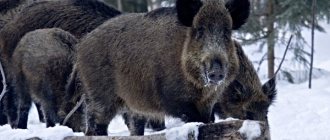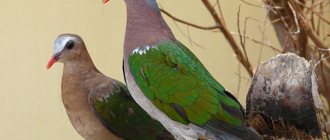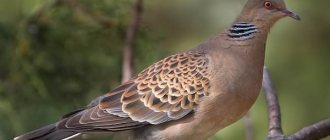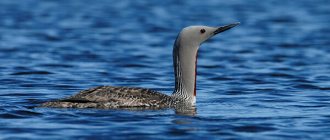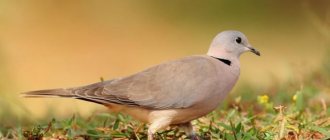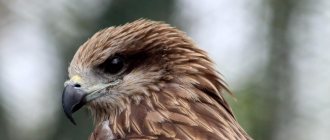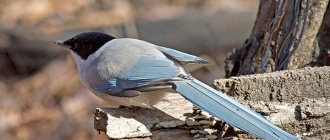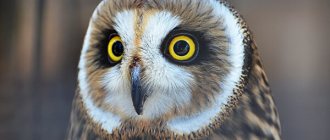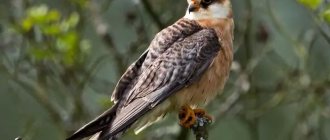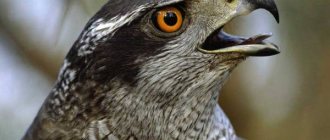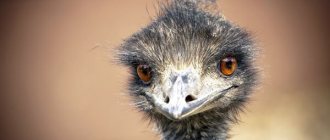The wood pigeon is a bird that belongs to the pigeon family. It is significantly different from our ordinary urban rock pigeons, which originate from wild ancestors who settled, and still settle, on inaccessible rocks, which ensures the safety of their chicks.
Wood pigeon wood pigeon is a bird that belongs to the pigeon family
Appearance and features of the bird
The wood pigeon is a relatively large wood pigeon, similar to its urban turtle dove cousins. Its body length varies between 38-46 cm, and the average weight is 460-600 g.
According to the generally accepted description, a wild pigeon looks like this:
- The head is small, proportional to the body.
- The eyes are round, with a dark pupil and a yellow rim.
- The beak is curved, red, with a pointed yellowish tip.
- The body is elongated, streamlined.
- The neck is gracefully arched.
- The paws are thin, pink-red, with sharp claws.
- The tail is small and opens in flight.
- The wings are relatively short. Their span is about 80 cm, thanks to which the bird can fly at a speed of 180 km/h.
Read more - “All about wild and urban pigeons.”
The color of the wild pigeon is in bluish-gray tones. The lower part of the bird's body and the inside of its wings are light blue. The tail feathers have dark ends. There is a white stripe on top of the wood pigeon’s outstretched dark brown wings. It stands out strongly against the background of almost black flight feathers.
There are clearly defined white spots on the sides of the wood pigeon's neck; they delimit the gray head and the bluish-purple crop.
The female has these markings slightly smaller than the male. The wood pigeon's neck is covered with plumage with a distinct iridescent tint. Young wood pigeons have a reddish color without the characteristic metallic tint and spots on the neck.
Interesting! The Latin name for the wood pigeon consists of 2 words - Columba palumbus. The first one translated from ancient Greek means “diver”. The second has an unclear etymology and is supposedly translated as “dove.” The bird may be popularly called a wood pigeon or vituten.
Depending on the color and size of the white spot on the neck, wood pigeons are divided into the following varieties:
- typical;
- Azorean;
- Iranian;
- North African;
- Asiatic;
- subspecies Kleinschmidt;
- Gigi subspecies.
The wood pigeon makes specific loud sounds “kru-kuu-ku-kuku”. The song that a forest bird starts sounds more like a hoarse howl than the cooing of a dove.
Origin
Photo of the bird:
Columba palumbus is the Latin name for this bird from the pigeon family. "Columba" is an ancient name for pigeons in Ancient Greece, derived from the Greek word meaning "diver" and given for the custom of some members of the genus to throw themselves upside down in flight.
The etymology of the word “palumbus” is not very clear, but it seems to also mean “dove”. Wood pigeon and vityuten are the popular names for this species, the history of which is hidden in the darkness of time.
Lifestyle
Vityuten is a typical forest wild pigeon. He tries to hide in the treetops and does not like to be disturbed.
The pigeon's lifestyle depends on the season. During the mating season, birds form pairs, and to fly to their wintering grounds they gather in numerous flocks. Wood pigeons move during daylight hours. At night, birds roost in tall trees with good visibility.
Although wood pigeons migrate along the same routes, there are significant differences in their behavior:
- in autumn wood pigeons stop to feed;
- During spring migrations, birds do not descend to the ground throughout the day.
Habitats
The breeding range of the bird covers Europe except the north of Scandinavia (in Russia the northern border reaches Arkhangelsk), the southwestern part of Siberia to the city of Tomsk in the east (some birds fly further), the Caucasus and Crimea, northern Kazakhstan, Central Asia, the Himalayas, China, Middle East, North Africa.
In most of its range it makes seasonal migrations. Lives year-round in southern Europe (starting from the south of England), southern Turkmenistan, sometimes remains in the Caucasus and Crimea for the winter.
It only winters in the Himalayas, the mountains of Afghanistan and the Middle East. In Africa (Algeria, Morocco and Tunisia), both local resident birds and migrants from Europe gather in winter.
Vityuten is a typical forest bird; only occasionally it can settle among bushes. Lives in forests of mountains and plains of any type, both deciduous and coniferous. It prefers not dense wilds, but edges and clearings, river banks, and forest belts.
In treeless steppe areas, it settles in forest belts, floodplain forests and forests. If possible, it avoids the proximity of populated areas, but where it is not disturbed, for example, in foreign Europe, it settles in city parks, under roofs, on balconies and near fields.
We have been noted in old parks near St. Petersburg.
Interesting fact: In England, the wood pigeon is the most common pigeon. Its population here is more than 5 million pairs. It lives in the parks and gardens of many cities and villages of the country, feeds on humans and can hardly be called “forest”.
Nutrition
The wood pigeon feeds mainly on plant foods, although occasionally it supplements its diet with earthworms and caterpillars. It mainly eats legumes, wild grains and grain crops.
The food preferences of the wood pigeon are formed taking into account its habitat. For example, in coniferous forests the pigeon feeds on seeds. Vityuten willingly eats acorns, beech fruits, lingonberries, viburnum, blueberries and strawberries. Under certain conditions, it can feed on young buds. And during a long winter, the pigeon feeds on cabbage and clover leaves.
On a note. This bird loves to pluck low vegetation and tends to store food. The wood pigeon's capacious crop can easily accommodate up to 8 acorns.
Breeding at home
Many pigeon lovers, having seen this beautiful bird in the photo, dream of adding it to their collection. But raising a wild pigeon at home is fraught with certain difficulties. First of all, it is necessary to select a pair to obtain full-fledged offspring.
It is necessary to select partners well in advance of nesting. When choosing breeding individuals, you must adhere to the following criteria:
- Only purebred birds are suitable.
- It is necessary to first study the pedigree.
- Inbreeding should not be carried out.
- To breed offspring, it is necessary to select females with good physical characteristics, without signs of obesity or thinness.
- To hatch chicks, adults older than 2 years should be used, since the first chicks of young animals may be frail.
Chicks begin to show their first independence at the age of 40 days.
At home, pairs of vityuten need to be kept separately, since living together can cause aggression. After all, every male will protect his female. But, despite this, a wild pigeon can easily coexist peacefully with other birds. According to experienced poultry farmers, vityuteni get along best with quails, pheasants, and partridges.
For successful nesting for a wild pigeon, you need to create conditions as close as possible to its habitat. Willow baskets suspended on ropes can be used as a nest. But you should remember the large size of the bird.
During hatching, birds become sensitive to stress, so they need to be protected from extraneous sounds. When favorable conditions are created, the Vityuten's offspring are born without any problems.
Important! It is forbidden to check nests during the period of feeding chicks, as this may result in the female abandoning the clutch.
Diet, how to properly maintain it
Initially, the offspring feed on “bird milk,” but for its full production, parents must receive a complete balanced diet and vitamins. To feed wild pigeons, you can use a combination feed intended for poultry.
Young wild pigeons, when raised at home, have a tendency to develop rickets. Therefore, it is also necessary to provide birds with mineral mixtures based on edible limestone, sand, and wood ash.
After 40 days, the offspring of the vityuten begin to leave the nest. At this point, the chicks already have a short tail and can try to fly. But during this period, it is necessary to prevent the next reproduction of adults until the offspring becomes completely independent, otherwise problems may arise.
- The basis of the diet for wild pigeons is wheat, which can be diluted with corn.
- In winter, it is necessary to feed pumpkin and sunflower seeds, peeled oats, and rapeseed.
- It is important that birds have free access to water at all times.
To keep vityuteni, you need to prepare a spacious dovecote, where the air temperature in winter will not fall below 10 degrees. The duration of daylight should be at least 12 hours. Therefore, if necessary, artificial lighting should be used.
Reproduction
The wood pigeon reaches sexual maturity at 10-11 months and is capable of laying eggs three times in a year. The mating season for the wood pigeon lasts from April to the end of September. A dove makes a nest from thick branches and flexible, strong rods. It is located no higher than 2 m above the ground and resembles a loose, flat-bottomed cocoon with several holes.
The male sits on the top of the tree and begins to coo loudly to attract the female. When attention is paid to him, he goes down and circles around his partner, cooing.
At one time, the female lays 2 small white eggs and incubates them for 15-18 days. At first, the hatched chicks feed only on pigeon milk from the crop of their parents, and a little later they switch to plant food. Young wood pigeons become completely independent by one and a half months.
What does a dove look like?
The wild pigeon pigeon has a large body with a length of up to 40 cm, and even more is found.
The wingspan is 75 cm. Unlike other species, the wood pigeon has relatively small wings and a long tail for a pigeon of this size.
We also recommend reading:
Quezali - the vanishing beauty of South America Gay penguins stole a nest with eggs from lesbian penguins Gray partridge - a unique assistant in gardens and fields Skillful conspirators. Why doesn't anyone see urban pigeons nesting?
The weight of the bird is from 500 g to 1 kg. This is a big dove.
The wood pigeon is an extremely cautious pigeon ; it does not like to show itself. When a person appears, this huge pigeon becomes silent and hides. The main color of the dove is gray with smoky and bluish shades. The beak is pink or yellow, the neck has a greenish color, the crop can be turquoise or lilac in color. The wings are decorated with white stripes.
Wood Pigeon Hunting
Interest in this sporting event is fueled by the fact that wood pigeons are naturally very cautious. To get them as a trophy, the hunter will have to show incredible restraint, patience and composure.
In the spring, you can use a decoy to hunt wood pigeons. A bird flies to a similar sound. In summer, a stuffed animal is used more often. Wood pigeons fly up to an artificial copy of the bird and sit down next to it.
Important! In Russia, it is prohibited to hunt wood pigeons using pneumatic weapons.
Natural enemies
Goshawk
In the wild, a fat pigeon is a tasty prey. Many predators sharpen their teeth and, especially, beaks on it.
Among the enemies:
- goshawk and sparrowhawk striking prey in the air and branches;
- the peregrine falcon is an unsurpassed feathered hunter, dexterous and strong;
- the gray crow is a “feathered wolf”, kills weakened birds, catches chicks and eggs on nests;
- the magpie and jay cannot cope with an adult bird, but they eat the eggs - in some places, according to estimates, up to 40%;
- The squirrel is also a big fan of bird eggs.
People cause a lot of trouble for pigeons and reduce their numbers both directly, by shooting them while hunting, and indirectly, by changing and poisoning their habitat.
Increasing population density forces wary birds to leave their nesting sites and move to wilder and more remote corners, of which there are fewer and fewer.
The use of pesticides, especially the now banned DDT, has greatly depleted the pigeon population. As well as hunting for them, which is now very limited. But the wood pigeon is a recognized pest of agricultural land, which does not allow hunting for it to be completely prohibited.
One cannot ignore such a factor of population decline as climatic conditions. Cold spring and damp summer lead to late nesting, so that the birds do not have time to lay a second brood.
Poor wintering conditions and lack of food lead to significant mortality: 60–70% of young pigeons and about 30% of adult pigeons die.
Interesting fact: Many wood pigeons winter in the Kuban. Flocks of thousands are only slightly thinned out by hunters, since permission to shoot is not issued every year and only until December 31.
In crowded conditions, an epidemic of candidiasis begins among pigeons, which causes much more harm than hunting. It is considered justified to extend the shooting season in order to reduce numbers and avoid overpopulation.
Population and species status
According to rough estimates, the global population of wood pigeons is 51-73 million birds. Most wood pigeons live in Europe. Wood pigeons are gradually settling in agricultural landscapes and expanding their range towards the Faroe Islands and Scandinavia.
Interesting! The Madeira subspecies of pigeons disappeared at the beginning of the last century. And Azorean wood pigeons are preserved only on the islands of San Miguel and Pico.
Wood pigeons are beautiful large birds with grayish-blue plumage, which helps them hide from enemies. They prefer to settle away from people and often become a hunting trophy.
Klintukh
This type of pigeon differs from its relatives in its beautiful plumage, which has a bluish tint. Besides:
- the neck and breast of the bird are malachite-colored;
- wings are slate blue, matte, with a transverse black stripe;
- the tail consists of dark feathers with black stripes;
- paws dark red.
Klintukh lives in the forests of Siberia, China, Turkey and Kazakhstan
In females, the color of the feathers is not as bright as in males, and they can be distinguished by this feature.
The main habitat of the clintuha is Türkiye, China, and Africa. They are also found in Siberia and Kazakhstan.
Representatives of the breed live mainly in forests, preferring not so much to build nests as to settle in tree hollows. Beech groves and linden forests are suitable for them. Nests in hollows are made from dry twigs.
Birds become especially secretive during the breeding season. Males, calling for a female, hide in the dense crowns of trees. In case of any danger, they instantly fly up and quickly disappear among the branches.
